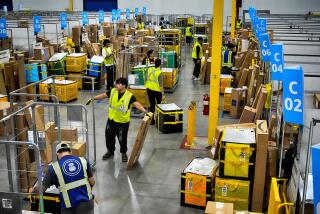Reports Point to Modest Growth in the Economy : Recovery: The government reported gains in factory orders and productivity, while jobless claims fell for a second straight week.
WASHINGTON — A fresh batch of government reports Thursday bolstered the growing belief that the economy is expanding.
The Commerce Department reported that factory orders climbed for the second month in a row during October, and applications for jobless payments kept falling as the economic recovery gained some momentum.
In another encouraging sign, the Labor Department revised upward its measure of third-quarter industrial efficiency, which raised hopes that leaner and meaner companies will push production up in 1993 and start large-scale hiring.
The value of orders received by U.S. factories rose by $4.1 billion, or 1.7%, to $244 billion in October--primarily because of more car and aircraft demand--after gaining 1.3% in September.
That bolstered other signs that the nation’s industrial sector was strengthening. But analysts said jobs and income gains were vital to sustain the acceleration. New figures on November’s unemployment rate are to be issued today and forecasts are for 55,000 jobs to be created.
Significantly, the Labor Department reported that jobless benefit claims dropped for a second straight week by 12,000 to 362,000 during the week ended Nov. 21. They have now declined in seven of the last nine weeks.
“It looks like the hemorrhaging of jobs finally has stopped,” commented economist Daryl Delano of Cahners Economic Inc. in Newton, Mass., though companies might delay adding large numbers of employees until next year.
“We really can no longer talk about mixed signals on the economy,” Delano said, “I think there are clear and unambiguous signs that the recovery is accelerating.”
On Thursday, the Labor Department said productivity--output per worker-hour that measures efficiency--actually rose 3% in the July-September period, rather than 2.6%.
“This is a major development for the economy, a structural development, because companies have significantly cut layers of white-collar management and these layoffs are helping industrial production,” said economist David Jones of Aubrey G. Lanston & Co. in New York.
Factory orders in October were pushed up by a 19.7% surge in transportation orders after a 5.6% decline in September. Excluding that segment, overall factory orders decreased by 0.6% in October after rising 2.2% in September.
A key component of factory orders, durable goods, rose by 4.1% in October after a 0.4% rise in September. Orders for non-defense capital goods, a measure of business expansion plans, were up 3.7% in October after increasing 8.6% in September.
But orders for non-durables such as clothing and paper products fell 0.7% in October after a 2.3% rise.
More to Read
Inside the business of entertainment
The Wide Shot brings you news, analysis and insights on everything from streaming wars to production — and what it all means for the future.
You may occasionally receive promotional content from the Los Angeles Times.










